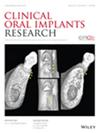Sinus Bone Graft Stability and Implant Survival Following Transalveolar Sinus Floor Elevation in Severely Atrophic Maxilla: A Retrospective Study With 5–8 Years of Follow-Up
Abstract
Objectives
To evaluate the clinical and radiographic results of transalveolar sinus floor elevation (TSFE) with grafting in cases of severely atrophic maxilla.
Materials and Methods
A retrospective analysis of clinical and radiographic data was conducted. Between 2015 and 2018, a total of 105 implants were placed in 105 patients over a follow-up period of 5–8 years. Implant failures and endo-sinus bone gain (ESBG) were assessed. Statistical models were established to investigate the potential influencing factors of implant survival and ESBG.
Results
Six patients with six implants were lost, resulting in cumulative survival rates of 94% for both patient- and implant-based analyses. The 8-year cumulative survival rate was significantly lower for residual bone height (RBH) < 4 mm (88%) compared to RBH 4–6 mm (98%). ESBG ≥ 4 mm and ESBG ≥ 6 mm were observed in 89.90% and 58.59% of implant sites, respectively. According to the log-rank Mantel-Cox analysis results, none of the factors examined were significantly related to implant failure, except for RBH (p = 0.038) at baseline. The linear mixed-model regression results showed that the final ESBG was positively correlated with implant insertion site (p = 0.003), implant length (p < 0.001), sinus floor elevation (SFE) methods (p = 0.010), and RBH (p < 0.001).
Conclusions
Within the limitations of this study, it has been established that TSFE with grafting was a reliable method for implant placement in the posterior atrophic maxilla ridges with RBH ranging from 4 to 6 mm. Nevertheless, caution was advised when considering its application in cases where the initial bone height falls below 4 mm.

 求助内容:
求助内容: 应助结果提醒方式:
应助结果提醒方式:


